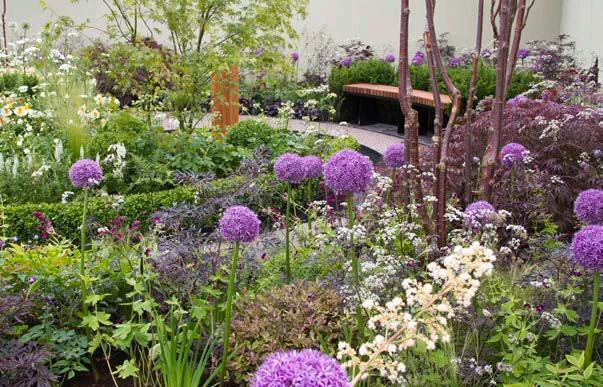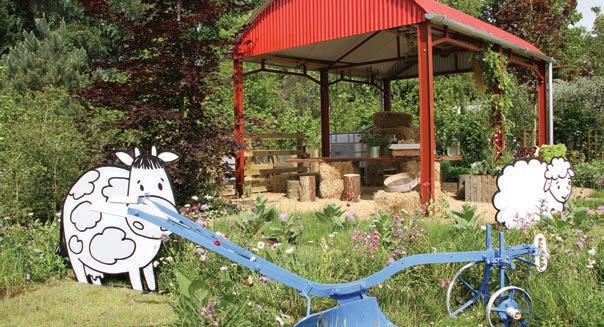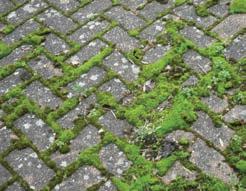
27 minute read
PROJECT MANAGEMENT – THE BEGINNING AND THE END
PROJECT
– the beginning and the end!
Advertisement
GLDA president, Patricia Tyrrell examines some of the practical aspects of successful garden project management
Where does design end and project management begin? As in many aspects of design there are several overlaps, and for me project management begins as soon as pen is put to paper to design a new project. One could argue that it begins before that. Lots of the decisions that are made on site before the garden designer is brought on board - for example access, poor site management leading to compaction issues, unnecessary tree removal etc. - have long reaching consequences for subsequent parts of the project.
Broadly speaking, project management for garden creation can be split into two categories: action and documentation. The former captures all that you do and the latter how you record and file it.
GET YOUR FILES IN ORDER
Before you agree to do anything for a client, ensure you have a well considered structure for filing and storing documents. It has taken me a long time to realise it, but there's a lot to be said for being well organised. For each job I undertake I begin with the same filing structure, which is essentially folders on my PC. These includes correspondence, contracts, works records, images, drawings, invoices and so on. As soon as anything is produced, it's filed. While this might seem like overkill to some, anyone who has managed a reasonably sized garden build will tell you it's not. For example, one recent large garden project has 60 plus various files ranging from pricing, imagery, revisions, contracts, irrigation and everything in between.
FORMAL AGREEMENT
Contracts for domestic gardens will be the subject of a follow up article, but it is impossible not to mention it in connection with project management. While you may not feel it necessary to have a legal form of contract, it is vital that you have a written record of what is agreed between you and your client. Your agreement should include scope, expectations, costs, payments, timing and potential additional costs. Don't be shy about this. I save myself time and money by being upfront on these matters.
KNOW WHO YOU'RE DEALING WITH
For small projects this can be very straightforward. You might have a single client and contractor. For larger projects you might find yourself dealing with architects, engineers, planners, electricians, plumbers, pavers and countless others. Get everyone's name and details, introduce yourself and make sure you know who is responsible for what.
GET YOUR FACTS STRAIGHT
I recall my early days of design,
wasting loads of time and money going back and forth with clients and visiting sites. Now I understand the value of solid information, and that information starts with your client. I think most experienced designers will tell you that garden design is as much about managing client expectation as it is about managing projects. To prevent issues arising, before I even visit a site I pin my clients down on their needs and desires. The process for achieving this is probably worthy of a separate article, but the outcome is a written and agreed brief, filed in an appropriate folder.
When you and you client are literally on the same page you can then focus on gathering site information. Remember, it is your client brief which frames how you survey a site. Like my filing, I have a set structure for site assessment to avoid problems and second visits. You really can't have enough site information. In addition to standard information such as dimensions, levels, falls, vegetation, hard landscape, aspect, exposure and so on, you need to record services such as manholes, gas, electricity supplies. Make sure you check under vegetation and debris; all sorts of things can be disguised and the forgotten manhole is sure to rear its ugly head just where you least need it to be. Digging up services at a later stage can cost time and money at best or cause a blackout for the neighbourhood at worst. I doubt there is a designer in the country who hasn't been caught out by services at some point.
Make sure to take lots of photos, notes and drawings. I've gotten into the habit of taking narrated videos in recent years. When I return to the office I disseminate all my data in written and plan form. If the brief is impacted I let the client know and record the change.
SEEK PROTECTION
Good gardens and landscapes are built on good soil and oftentimes when I visit sites, particularly where building is underway, one of the first things I do is seek protection for the existing landscape. By and large, Irish builders are atrocious at looking after soil. It is simply a medium to build on, or worse, it’s just dirt. Do whatever is required to protect the existing landscape, no matter whose nose you put out of joint. And undertake proper soil analysis. It is so important to understand what kind of soil you have and conditions be they wet or dry that will impact on planting later. If the site has been top soiled, do some digging. You might find a cosmetic layer of screened soil covering a multitude of sins. Again, record your findings and communicate.
Other elements that might need protection include trees and mature plants. Builders love driving all over the garden and storing equipment and supplies under trees. It’s important to spoil their fun by restricting where they can go. Trees need to be fenced off in advance of works on site, and as much of the garden as you can reasonably negotiate with them should also be fenced off. This will reduce costs later as less damage will be done.
KEEPING IT REAL
Designers are a creative lot and can get lost in their own ideas, only to find later on that those ideas won't translate.
As you design it’s important to keep any restrictions in the back of your mind, and that’s apart from the budget. For instance, if there is no access to the back garden, then unless you have a massive budget there is little point in designing something which involves moving large quantities of materials in or out. Better to work with what you have if possible. Constraints on a design can actually make it better. The last thing you want is to be trying to manage an unbuildable scheme.
GOING SOFT
Planting is one of the most challenging aspects of project management. Trying to manage your clients’ wish for an instant garden in the face of plant sizes, availability, budgets and planting timing causes more than a headache or two, particularly on extended or delayed works. It is vital to communicate with clients and stakeholders on planting to ensure they all understand the implications of any changes to original plans. While I personally prefer to do layouts in situ this is not always possible, and I find it increasingly important to have trustworthy and knowledgeable contractors who can be relied on to carry out works as instructed. Remember, it all comes back to you in the end.
Another issue with planting is substitutions. Some cheeky nurseries will make cultivar substitutions without communication. Thankfully they are in the minority and most will make suggestions first. Be sure you retain delivery dockets for your records and preferably buy on site so that when plants are delivered you can inspect and record them as delivered. You have little come back when they're in the ground.
BETWEEN A ROCK AND A HARD PLACE
When detailing hard landscaping such as paving, make sure you know the dimensions and depths. Combining paving with different depths will not make you popular with your landscape construction team. Make sure too that your design is a multiple of the paving dimensions to avoid endless cutting. And unless you can really, really justify it as something vital in your design, don’t go for fancy angles in your paving that will involve each one being painstakingly cut. Look at local regulations to ensure your design is compliant.
Finally when your design has been approved by the client, build it in your head. Go through each stage and think of the possible opportunities or pitfalls. There will always be something you have missed. During the construction phase, make sure you visit at key stages such as setting out, foundations and finishing. Record everything and demand changes to deviations from plans. Don't be bullied by contractors.
THE RIGHT BUILDER
To avoid major headaches, find some good landscape contractors and build relationships with them. There are other options. It may be that the builder has a price in for site works and landscaping, and for simplicity the client may want to use them. This can work, though there are not many horticulturists in the building profession so it can have drawbacks. Direct labour is another option, where specialists
are brought in for each part of the job. This was easier to do in the past, but now contractors are so in demand that it can be difficult to make it work.
Whoever you are working with, communication is key. The best form of communication is your detailed drawings and specifications. Everything needs to be carefully detailed. It’s so easy to think that what is in your head has been successfully transferred to your contractor by the power of the spoken word, but that’s often not the case.
TIMING IS EVERYTHING
A brilliantly designed garden can fall very flat if the build is not managed correctly. This is relatively straightforward for small jobs but can quickly spiral out of control for large projects. Over the years I have learned that successful builds are based on the skills of a realistic designer, an experienced contractor and a reasonable client. If you are new to the game then I suggest you always use of a programme of works. Even if it is not stuck to rigidly, it will help provide a general structure to work to.
If there was an ideal schedule for building a garden it would be doing all the hard landscaping in the drier months and the planting in the autumn. This is optimum, ensuring less soil damage and also that the plants go in when the soil is still warm, thus establishing quicker and needing less maintenance. It’s what one might consider a sustainable approach.
Spring or summer plantings will need high maintenance and as part of the project management this needs to be provided for by specifying irrigation in some form. On a minor scale this could be as simple as making sure there is an outside tap, all the way up to installing an irrigation system. Regardless, sowing, turfing and planting are always the last jobs to be done.
AFTERCARE
Aftercare is often overlooked in project management, but is critical to the creation of a great garden. I like to use a maintenance schedule where possible. Having said that, I will forgo this when I’m working with a contractor or gardener who knows what they're doing.
DUCKS IN A ROW
Project management is not rocket science but failure to attend to it will negatively impact the quality of your product, your bottom line and your stress levels. Do yourself a huge favor and get yourself organised. Find a system that works and stick to it. ✽
PATRICIA TYRRELL
is a landscape architect, garden designer, horticulturist and gold medal winner. She can be contacted via her website at living-landscapes.com
GLAS
STAND #A1


































































































BLOOM
Renowned landscape and garden designer, Angela Binchy shares her thoughts and insights on this year’s crop of Bloom show gardens
In a world growing in fear and distrust and selfishness it was heartening to find Bloom 2017 celebrating diversity, inclusivity, and cooperation with the unifying factor being our dependence on nature.
The show gardens were an eclectic mix of designer and artisan talent showing a diversity of functionality and style. There was contemporary luxury and elegance in the form of 'Living Oasis' by Kevin Dennis, conceptual ideas were explored in Hugh Ryan’s 'Stem Cell' and Niall
Maxwell’s 'World Without Walls' and Tünde Szentesi used an agricultural theme to underpin her 'My land Your Land' garden for Agri Aware.
Nothing was too small nor too extraordinary, even little dogs had a boutique garden. Further afield, country garden clubs and school children were featuring their locality in miniature postcard gardens and loving the buzz of the show.
There was disappointment too. A good idea calling for plant decoration on the doorsteps of different style houses somehow didn’t really take off. Let's hope for better next year. A big disappointment was the sculpture garden, which was always enjoyable in previous years. An 'in your face ' black shiny plastic matting on the walkway was off putting and the small sculptures, some very nice, were lost in an over decorated space. Again, let's hope for better next year and a return to sculpture in a suitable garden setting.
Now to get to the nitty gritty of the show gardens. The general standard was pretty high and the planting had definitely improved. There were exceptions but planting is still 'show-gardenesque' with very close plant spacing, which is admittedly better than showing areas of blank soil.
A flowering meadow style appeared to be popular. It looked pretty but in one garden I counted up to 13 different species or varieties in one square meter. Not all the plants used would survive in this style.
Judging, always a contentious issue, was less so this year
I thought, and I heard fewer grumbles. There was some head scratching about the best planted garden. The show catalogue partially explains the judging system, such as a garden is judged under headings: ● meeting the design brief ● overall impression/design ● construction ● planting
For a gold medal, 75+ judge's marks are required, down to 45-54 marks for bronze. Below that there is no award. Incidentally the word 'like' is banned from use by the Chelsea judging panel. It would be helpful if we knew how many marks were available for reward under each heading, and also the actual marks finally awarded. It is surely helpful to everyone to know what experts find unsatisfactory as well as excellent. From a wider perspective, transparency and articulation of marks can serve as a tool for educating the public, helping to build a better understanding of what constitutes quality. Bloom's lead judge, Andrew Wilson, among others, had the marks for his recent Chelsea gold medal garden read out by Monty Don on TV. The Super Garden competitors do not mind being criticised in front of the nation on TV so Bloom designers should not mind their faults being publicised. The judges hide in a large group and they should not mind. So who is being pandered to?
It is also surely rest time for some of Bloom's judges. Andrew Wilson has been lead judge since the show's inception 11 years ago. I can say this because I was a member of the Bord Bia Horticulture Board during the inception and birth of Bloom, and knowing Andrew who was both a participant and a judge at Chelsea Flower Show I introduced him to Gary Graham as an excellent advisor in the establishment of Bloom. That he has been, he is very knowledgeable in the running of a world class garden show and an excellent garden designer. He is one of the few speakers who was asked to speak twice at the GLDA’s international garden design seminars. Some of the other judges have also given long service. In any of the disciplines I can think of where judging is subjective (think Crufts Dog Show or the Dublin Horse Show), judges change annually or at least after a certain period. It’s not a reflection on their judging; it’s done to keep judging broad and fresh. They can always be asked back and it would be great to give the likes of Dan Pearson, Cleve West or Sarah Eberle a turn as an overseas judge. The show gardens offered some interesting concepts and ideas, which were well designed and executed. Niall Maxwell's concept for Oxfam Ireland and GOAL was original, topical and thought provoking in its simple yet subtle presentation. Titled 'A Garden Beyond Walls', a number of huge blocks of the ugly, eight foot high dividing wall were removed and reassembled as colourfully painted seats in communal gathering spots in an open space. Delicate plants took root and flowered around the now inviting seats. Mirrors were placed in the gaps of the ugly wall, reflecting the garden




to symbolise the similarity of life both sides of the wall. It was a big message, simply executed, and perfect for reproduction in a public park. A well deserved gold medal and award for the best concept garden.
For me gardens must stimulate some mental or sensuous reaction, and Oliver and Liat Shurmann's 'Transition' garden for FBD Insurance did it in spades. I was immediately transported to a friend's magical hideaway beside a sheltered Atlantic sea inlet near Moyard in north Connemara, by the sculptural delicacy of the trees and glass shelter, the cool palette of green, white and black, the hypnotic effect of the very slowly receding and returning water from the jagged black schist rocks, the reflected passing clouds on the water - and that is the garden! It was truly a space to induce mental and physical healing, and what a feat of hidden mechanical engineering and laying of geologically correct rock formations. All plants were supplied by the Schurmann’s own Mount Venus Nursery. The gold medal and best large garden award were truly merited.
In contrast Alan Rudden's garden 'Urban Retreat' for Savills left one emotionally blank. The garden looked as if it belonged to a wealthy banker who spent most of his free time in the Caribbean. Well done to Alan if this was his client! The garden was well designed and skilfully executed by his company Outside Options, with cuboid architectural forms enhanced by good colour tone combinations of brown and grey hard materials with green and white planting. The latter was a mixture of formal green blocks, mostly of an interesting dwarf pine Pinus ‘Pierrick Bregeon’ with puffs of Allium ‘Mount Everest’ through it and informal shaded beds with 13 very tightly packed species and varieties of green and white flowered perennials such as Hosta seiboldiana ‘Elegans’, Geranium phaeum ‘Album’, and Polypodium vulgare 'Bifidomultifidum'. All plants were good quality, and supplied by Tully Nurseries, Campbell Plants, Yellow Furze Nurseries and Rentes. A deserved gold medal but it did not appear to have been a popular choice for best planting.
On the other hand, everyone seemed delighted with this year's Super Garden 'Rustica Hibernia', a surprising but well presented hillbilly arts and crafts garden. Both the garden and the designer/builder, Des Kingston were bursting with personality, interest and fun. I found myself joining a large happy group of people gathered around the garden singing the Garden Song - “Inch by inch, row by row ….” along with Des and a group of minstrel singers! "Man is made of dreams and bones, feel the need to grow my own... Tune my body and my brain to the music of the land...". RTÉ and Bloom, keep Des within your sights.
Hallelujah! At last Dublin City Parks have great plans to tree fill and green our capital city with interesting and bee
1 Oliver and Liat Schurmann’s 'Transition' garden for FBD
Insurance 2 Dara O’Daly’s garden for Dublin City Council (DCC) Parks &
Landscape Services captured plans to green the capital 3 Alan Rudden’s garden for Savills won both gold and best planting 4 The Teagasc 'Garden of Hope' for Pieta House by Teagasc staff members Laura Cassin, Louise Jones and Linda Murphy
PHOTOS: KORALEY NORTHEN
friendly natural and sustainable planting and well placed seating. So we were told by their landscape designer Dara O'Daly in their attractive, educational and well planted walk through garden dominated by a mighty fine oak tree with a 6ft rootball (Quercus palustris supplied by Annaveigh Nurseries) and featuring an inviting very long sculpted oak log seat. If the garden is anything to go by, happy days ahead. The garden was built by MCD Landscapes. It was awarded silver gilt, I thought it deserved a gold.
Finally and tellingly, the people's choice garden was an attractive, simple, stress relieving, circular flower garden of shrubs and herbaceous perennials graduating from dark colours to bright white, centred on a beautiful, uplifting sculpture by Michele Hannan. True to its title it was a 'Garden of Hope'. Admirably designed and assembled by Louise Jones, Laura Cassin, Linda Murphy, and a team of Teagasc horticulturists led by Paddy Smith for the suicide prevention charity Pieta House. It was judged also a worthy gold and best medium size garden.
Perhaps it is time to update the categories for show gardens and the information signage with them. Signs for the postcard gardens were more informative and easier to read than those with the show gardens.
CATEGORY SUGGESTIONS:
● Pleasure gardens based on ANGELA BINCHY the traditional perceptions is a renowned of what a pleasure garden landscape and garden should be, such as John designer, a founding
Durston's calm and member of the GLDA, beautifully planted 'Nature's and an active industry
Resurgence' for Ria Organics. commentator. ● Reproductions - installations of miniature natural or manmade landscapes or historic gardens that are of public interest or are under threat of damage or extinction, such as the popular miniature farm exhibit 'My
Land, Your Land - Ireland' designed by Tünde Szentesi for Agri Aware. ● Novelty gardens which try to convey a cause or message, or tell a story where plants and materials might be used to represent other elements such as 'The
Strawberry Bed Garden' by Maeve O’Neill with its bedstead seats over a miniature 'river' water feature. Another garden that would qualify as "novelty" would be 'On Cloud Canine' designed by Brian Burke for Dogs Trust. It was a good idea to have a dog friendly garden but unfortunately this one, while pretty, left scale and practically off the wall. ● Merchandise gardens which blatantly advertise products or services such as the 'Despicable Me 3' garden which was well designed and executed by Bríd
Conroy for Universal Studios. It was a quirky, colourful, fun garden popular with youngsters following in the footsteps of the Tayto Park garden in 2014, but hardly fair to judge it in the same class as the 'Garden of Hope'. In fact surely such commercialised gardens if there at all should be in a separate section similar to the postcard and doorstep gardens. All gardens should be judged to the same high standard of accepted garden design and horticultural best practice and there should always be an award for the best concept. What I would worry about is a slip towards powerful commercial interests getting a hold and commercialised honky-tonk elements creeping in. Instead, we could get builders and developers some way involved with gardens that have an emphasis on good soil preservation and maintenance. ✽


5. 'A World Beyond Walls' by Niall Maxwell for Oxfam Ireland and GOAL - 6. Des Kingston’s Super Garden winning arts and crafts garden 7. 'Living Oasis' for Santa Rita by Kevin Dennis - 8. 'My Land, Your Land - Ireland' by Tünde Szentesi


“Plant heritage is worth cherishing and merits a place of honour in our gardens”

Hydrangea macrophylla ‘Beauté Vendômoise’ Hydrangea macrophylla ‘Hortulanus Witte’
Suppliers of Quality Trees & Hedging



Fána Nurseries is a top quality producer of trees ranging in size from 6-8 bare root to 30-35 girth root ball. The height to girth proportions of the trees is excellent and our bare root trees have excellent fibrous roots.
Our range is available from 12-14 girth upwards have been transplanted three to four times depending on the size tree. The attention to detail and excellence is clearly seen in the quality of production.
40 Acre Tree Nursery . 35,000 Trees in Production . 60 Different Varieties Sizes up to 30-35cm . Excellent Quality Stock Supply & Delivery Nationwide
Hydrangea macrophylla ‘Gertrud Glahn’ Hydrangea macrophylla ‘Le Cygne’

• Unique collection of over 150 ‘old’ Hydrangea • Limited quantities in 4 or 5 litre pots • Many more varieties on-site • Propagation available for specific projects on demand
Tel: 087 9012388 / 087 2969125 Email: tgmartincmx@gmail.com Facebook: www.facebook.com/hydrangea.ie Glenview House Mullantlavan Carrickmacross Monaghan

Suppliers to the Trade of
w Topsoil w Compost w Bark w Lawn w Pebble w Tools w Sleepers w Fecing w Sand & Gravel w Winter Salt & Supplies

We have invested in a new grab truck and can now offer delivery of 20 tonne loads of screened soil to landscapers and local authorities.
LANDSCAPE PROVIDERS Cabinteely, Dublin 18 tel: 01 2899322 email: info@landscapeproviders.ie www.landscapeproviders.ie
Fána Nurseries also supplies bare root and root ball hedging like Fagus, Taxus, Buxus and Prunus.
We invite you to visit our nursery and see the quality production for yourself www.fananurseries.com
GLAS
STAND #J10
Ballyhooly, Co Cork . 025 39860 . fananurseries@gmail.com
New-Way Weedspray Non-selective herbicide for weed and moss control.

AMENITY PRODUCTS www.headlandamenity.com
GLAS
STAND #L6
l Approved for weed and moss control on hard surfaces l Fast acting - weeds die 1 to 2 days after treatment l Formulated from naturally occurring ingredients l For professional use only
Distributed by: CropCare - 01 287 4485 info@cropcare.ie www@cropcare.ie
New-Way Weedspray contains 240g/L Acetic acid. PCS No. 05603. Use herbicides safely. Always read the label and product information before use. Please refer to the product label or our website for further technical information.








